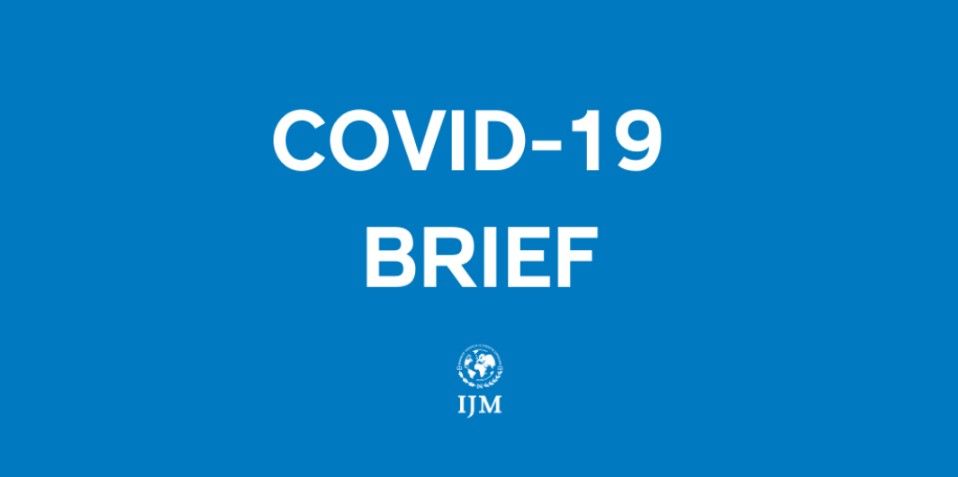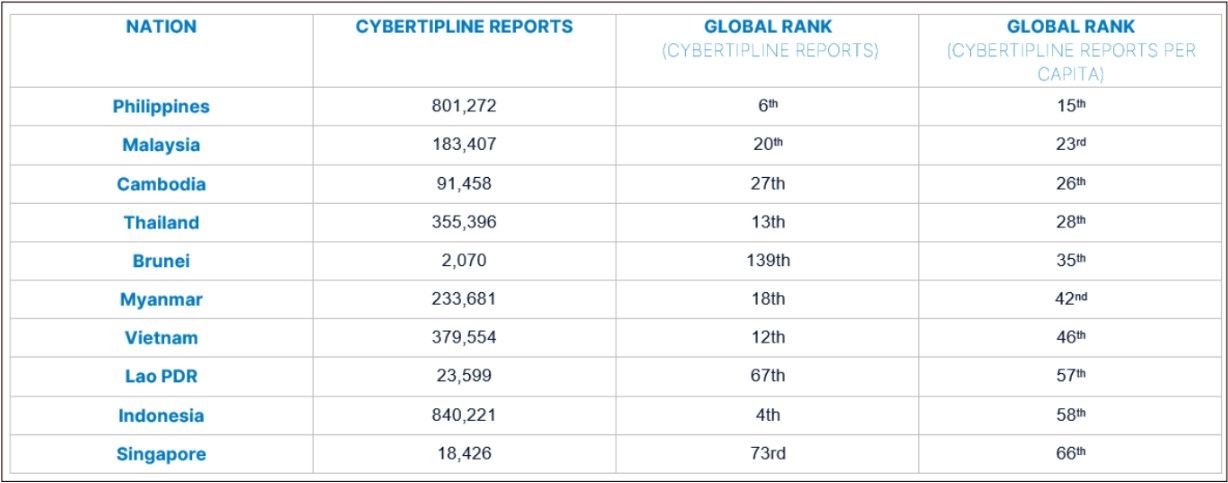
Updated: April 2021 | Download PDF
Online Sexual Exploitation of Children Background
Historically, many nations in ASEAN (Association of Southeast Asian Nations) have been a destination for foreign and domestic offenders seeking to sexually exploit or abuse children in person. These offenders can now use numerous mobile and online tool—including social media, online networks, live-streaming applications, video-sharing sites, and the dark web—to direct and watch live child sexual abuse with relative anonymity.
Internet-based child sexual exploitation in various forms may be occurring in ASEAN nations with minimal detection and reporting to document the scale or prevalence or to identify victims in urgent need of interventions. This broad category of online harms includes the direct manipulation or “grooming” of children by sex offenders online, the distribution of previously produced child sexual exploitation materials (CSEM), and the trafficking of children by adults to create new CSEM, the form of online sexual exploitation of children (OSEC) that IJM has combated in the Philippines since 2015. These new CSEM can take the form of photos, videos or live-streamed abuse and are often produced commercially (in exchange for compensation of some sort, usually money).
In OSEC, sex offenders communicate online with traffickers, paying them to live-stream sexual abuse and exploitation of children directed by the remote offender in real time. In the cases IJM has worked on, the abusive conduct in online sexual exploitation of children is rarely limited to erotic displays. It usually includes forcible sexual penetration constituting rape in the Philippines and most other jurisdictions. Footage and chat records reveal that sex offenders issue specific and graphic abuse instructions to in-person traffickers.
The demand for live-streamed OSEC in the Philippines is largely fueled by foreign sex offenders. The same may be true for other ASEAN member nations, but research is needed to confirm.
Based on IJM’s own data from its collaborative casework in the Philippines, OSEC traffickers are typically financially motivated adult female (about 65%) relatives or close associates (e.g., neighbors) of victims, about half of which are 12 years old or younger at the time of rescue. About 20% of victims are boys; this is a much higher representation of boys than typically seen in establishment and street-based sex trafficking.
Typical online sex offenders who direct and purchase OSEC from the Philippines—by sending payment through money transfer agencies—are sexually motivated, English-speaking men in or from demand-side countries (in regions such as Europe, North America, and Australia). The very limited data available indicates that, among confirmed criminal OSEC buyers with known ages, more than half are 50-59 years old.
More information can be found in IJM’s OSEC Study, Online Sexual Exploitation of Children in the Philippines: Analysis and Recommendations for Governments, Industry, and Civil Society.
Download the Full Study Download the Study Summary Watch the Webinar (English Subtitles Available)
ASEAN Nations Snapshot: National Center for Missing & Exploited Children: CyberTipline Reports
The U.S.-based National Center for Missing & Exploited Children (NCMEC) has published data related to CyberTipline reports received from electronic service providers and other sources in 2019. NCMEC made available to 242 countries or territories, including ASEAN member nations, CyberTipline reports related to online child sexual exploitation of all forms. The table below lists ASEAN member nations with their corresponding 2019 CyberTipline reports totals, global ranking by number of CyberTipline reports, and global ranking by number of CyberTipline reports adjusted for population.

COVID-19 Implications, Increased CSEM Distribution, and Increased Risks of OSEC
There has been for years, and continues to be, a growing global demand by sex offenders for new child sexual exploitation materials. That demand includes in live streaming, as the UK National Crime Agency considers livestreaming one of the emerging threats to children today.
During the pandemic, governments and partners around the world are reporting a surge in violence against women and children, including online, exacerbating the vulnerability of children. COVID-19 lockdowns created the perfect storm for increases in online sexual exploitation of children. OSEC as committed by traffickers is a crime of opportunity. Moreover, quarantined child sex offenders are spending more time online and vulnerable children are also confined at home, often with their traffickers.
In April 2020, the UK National Crime Agency (NCA) predicted a rise in online child sexual abuse during the COVID-19 pandemic, while the WePROTECT Global Alliance released an Intelligence Brief on the impact of COVID-19, indicating the “highly probable” increase of online child sexual exploitation.
As the data below show, those predictions are in many ways substantiated, meaning there has never been a more urgent time to strengthen systems that protect children from OSEC.
-
For instance, the eSafety Commissioner, Australia’s national independent regulator for online safety, recorded an 86-percent increase in image-based abuse reported to its office over the three weeks preceding April 9, 2020.
-
The Australian Federal Police (AFP) and the Australian Center to Counter Child Exploitation (ACCCE) have observed the emergence of child abuse forums established as a result of COVID-19 stay-at-home measures. Moreover, they learned about child sexual abuse sites crashing during the pandemic due to the increased volume of traffic.
-
In April, May and June 2020, reports to the ACCCE increased by 122% compared to the same period last year.
Similarly, data and case investigations out of Europe equally reveal that demand-side child sex offenders pose a significant and growing threat to children globally and must be restrained through improved private industry detection, international law enforcement collaboration, and appropriately strong sentencing. For example:
-
In March 2020, Europol reported significant increases in the downloading of CSEM in Spain and attempts to access CSEM websites in Denmark.
-
The UK National Crime Agency’s most recent intelligence shows there are at least “300,000 people in the UK who pose a sexual threat to children,” including online;
-
In July 2020, Germany reported on a “30,000 suspect” investigation involving CSEM production and sharing, leading to the largest such prosecution in German history involving children as young as three months old; and
-
In July 2020, Europol announced a “massive investigation” in Italy combating online child sexual abuse.
Because OSEC is a global crime of supply and demand, the increased demand in CSEM can easily lead to increases in new sex offending against children to meet that demand. In their Exploiting Isolation report released in June, Europol states:
- “The demand for such [CSAM] material perpetuates the ongoing abuse of children by [offenders] and others. It is likely that the increase in the circulation of online CSAM in recent weeks will continue to feed the cycle of physical sexual abuse of children and their victimization in real life and online.”
Further, a July 2020 report by the Organization for Security and Co-operation in Europe’s Office for Democratic Institutions and Human Rights (OSCE-ODIHR) and UN Women noted an increased number of reports of child abuse during the period of COVID-19 emergency measures, including new ways to sexually exploit and abuse children, such as the livestreaming of child sexual abuse. The report also acknowledged isolation with potential perpetrators as an additional risk factor for children to become victims of trafficking, especially for the purpose of sexual exploitation.
In the Philippines, the trafficking of children to create new CSEM has continued during the pandemic, as has the collective response to this crime. During the lockdown in the Philippines, collaborations among domestic and foreign law enforcement, in partnership with IJM, has led to 20 Philippine law enforcement-led operations that rescued and safeguarded 76 victims and at-risk individuals, and arrested 16 suspected OSEC traffickers. In one such case, 15 victims—13 of whom are minors—were safeguarded during an operation in Mindanao. The Philippine Department of Justice, for its part, also secured three convictions against OSEC traffickers through e-promulgations or judgment hearings.
Finally, in the midst of all these increased reports of CSEM distribution and disturbing cases of child sexual abuse to create new CSEM, the true increase in the incidence of OSEC remains unknown. The reality is, to our knowledge, electronic service providers are not currently detecting livestreamed abuse or production of new CSEM, while financial sector entities (i.e. money transfer agencies and banks) are generally failing to detect and report suspicious financial transactions related to child sexual exploitation. As a result, it is difficult to measure the increase in the actual incidence of OSEC as a result of the COVID-19 crisis. Still, NGOs, global law enforcement, and government officials remain deeply concerned about continued increases in reports and other indicators of the increased threat of OSEC corresponding to the pandemic.
Response Considerations
Prioritize Protection from Violence. It is critical for all governments to prioritize protecting vulnerable populations from violence as part of their response to the pandemic, so that vulnerable populations made even more vulnerable by the pandemic are not left without the protection of the law. Among the most vulnerable are children trafficked by adults to create new CSEM, including in live streaming.
Resource Specialized Law Enforcement. ASEAN member nations and all governments can ensure that their law enforcement units with a mandate to investigate and intervene in OSEC cases have the necessary resources (including proper budget, staffing, PPE) to investigate OSEC cases, rescue victims and arrest perpetrators during the pandemic. This could be a core component of the ASEAN Regional Plan of Action and National Plans of Action to implement the Declaration on the Protection of Children from all Forms of Online Exploitation and Abuse in ASEAN.
Increase International Collaboration. Increased collaboration with foreign law enforcement agencies who can provide referrals to domestic law enforcement can help uncover OSEC cases that may otherwise go undetected while children are at home without access to friends, teachers, or others to whom they might disclose.
Improve Tech Detection & Reporting. Artificial intelligence technologies deployed by device manufacturers and electronic service providers, including social media companies, are urgently needed to significantly improve the timely detection, disruption, and reporting of OSEC crimes. We need to imagine a world where offenders cannot so easily create and share live streams, videos and photos of the most horrific crime scenes of child sexual abuse.
Improve Financial Detection & Reporting. Improvements in the use of OSEC indicators or signals by international money remittance agencies and correspondent banks to proactively detect, disrupt, and report OSEC suspicious transactions is critical to timely identification of offenders and interventions to protect victims.
Resource Social Services. Ensure social service agencies have necessary resources to provide critical recovery and rehabilitation services to survivors of all forms of OSEC. Utilize trauma-informed child-protective measures in all OSEC prosecutions, including remote testimony for child victims.
About IJM
Established in 1997, International Justice Mission (IJM) and our partners collaborate with local authorities to strengthen justice systems, building communities where all people can expect to be safe and protected. As justice systems serve survivors and hold criminals accountable, potential perpetrators realize they cannot abuse and exploit people without consequence—creating a powerful deterrent. Through this protective effect of our work, IJM and our partners are helping local authorities protect more than 400 million people from violence.
We currently work to combat slavery and other violence in 21 program offices in Africa, Latin America, Southeast Asia, South Asia, and Eastern Europe. IJM has supported governments, partners and other NGOs in rescuing and safeguarding over 50,000 people from slavery and other forms of exploitation and violence.
About IJM’s Center to End Online Sexual Exploitation of Children
IJM’s Center to End Online Sexual Exploitation of Children partners with governments, industries, NGOs, and other stakeholders to expose, neutralize, and deter the online sexual exploitation of children around the world. Leveraging practices proven effective in IJM’s ongoing program against OSEC in the Philippines, the Center will help (1) improve the detection and reporting of OSEC by technology and financial sector platforms, (2) strengthen international collaboration in law enforcement and prosecution, and (3) support effective justice system (law enforcement, prosecution, and aftercare) responses in source and demand-side countries, resulting in sustainable protection for children and accountability for perpetrators. [email protected].












